The Court Leet and Common Land
A number of aspects of open field farming demand a high level of co-operation between farmers. This was particularly true in Laxton until the mid-twentieth century, when animals were allowed to graze on the open fields at certain times of year. The mechanism by which these aspects are monitored and regulated is the Court Leet of the manor. Manor courts also sat in many other Midlands villages until enclosure did away with the need for communal control of agricultural land.
Farmers work separate strips in the open field. Boundaries between cultivated strips, roadways and sykes (uncultivated grass areas) are marked by simple stakes. The Jury, appointed by the Court Leet, checks each autumn that the common areas of the open fields are in good condition. They report if someone has encroached onto a roadway by ploughing too far, sprayed the sykes with weedkiller, or failed to clear a ditch. Infractions are punished by fines.
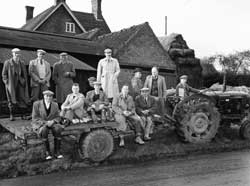
Laxton Jury assembling on Jury Day, c.1960. From Ch Pc 1
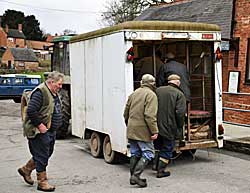
Laxton Jury assembling on Jury Day, 2008
On Thursday 27 November 2008 the Laxton Jury inspected West (Top) Field. The field being inspected is always the field which was fallow the previous year but which has just been ploughed and sown with winter wheat.
A strict crop rotation is in place in the open fields. Farmers must sow winter wheat in their strips in one field, other cereal crops in the second field, and leave the third field fallow. The rotation means that crops are sown and harvested at similar times of year. In the past, this meant that the fields could be ‘broken’ and animals allowed in to graze on an appointed date. There were lots of presentments to the Court Leet complaining that animals were let onto the fields before the field was broken, endangering the growing crops.
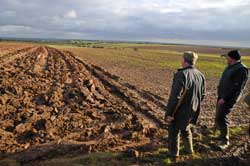
Members of the Laxton Jury inspecting the boundary between two strips, 2008
The boundary between neighbouring strips is marked by a deep double-furrow. The Jury uses its local knowledge, and the existence of old boundary stakes, to decide whether the boundary is a true one.
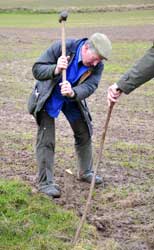
Bailiff of the manor hammering in a boundary stake, 2008
Stakes are placed where two strips meet at a roadway or syke. They are supposed to last for three years until the field is inspected again.
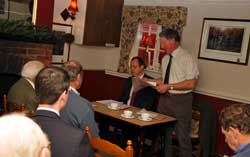
The Laxton Court Leet, 2008
The Court Leet is traditionally held in the Dovecote Inn. In 2008 it took place on Thursday 4 December. The Bailiff opens proceedings by calling all those who owe suit to the court to draw near. The Steward sits alongside him.
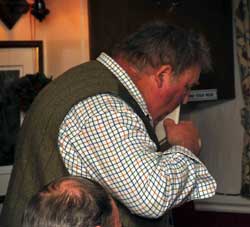
A Jury member being sworn in, 2008
Jurors indicate their acceptance of the oath sworn by the foreman by kissing a pocket Bible. This particular Bible has been used since 1798.
In the nineteenth century all people who occupied land or held common rights in Laxton or Moorhouse were called to the Court Leet. The suit roll gives their names and was annotated to show whether they appeared or essoigned, that is, did not appear. A fine of two pence for not appearing is still collected today. A Presentment Paper records the decisions of this Jury, made after their inspection of the fallow field on Jury Day. Common presentments were for ploughing up the Common, for leaving lumps of soil on the Common, and for not attending the court.
There are examples of a suit roll and presentment papers on the Laxton: Living in an Open Field Village resource on the Manuscripts and Special Collections website (Theme 2, Documents 5-8).
More: Pigs
Laxton: Farming in an Open Field Village home